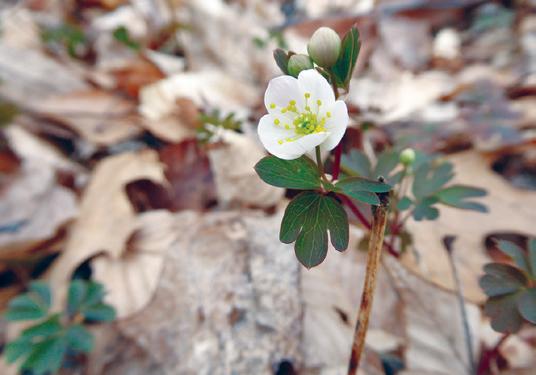
3 minute read
FIELD NOTES: Ephemerals
~by Jim Eagleman
The ground outside my window is more white than brown right now. Next week’s predicted rain will dissipate the remaining snow—the moisture from both adding to my native plant area and the experimental Hugel mounds I wrote about in earlier Field Notes.
Another order from a native plant nursery should arrive soon, and the mere thought of warming temps makes me anxious. Spring is coming!
The first spring wildflowers: hepatica, spring beauty, rue anemone, toothwort, and others, are referred to as ephemerals, the early bloomers. Their first-of-the-year brilliance is the color I look for, from monochrome to sudden pastels, bathed in the sun’s warmth that slowly dries mats of dead leaves. These plants appear quickly from the sun-flected forest floor, while the canopy overhead is still open.
In a few days, the flowers push into the cool spring air, fueled by storehouses of energy from the previous year. Some of them grow from hidden, below-ground stems called rhizomes, others emerge from corms or fibrous roots. Only after the plants have leafed out will photosynthesis boost survival. This strategy helps them persist in the light-hungry world of the chilly woods.
Once rapid growth has reached this point, we momentarily inspect these beauties. Don’t plan to return in a few days with a camera or flower book—they will have probably disappeared. “Short-lived” is their trademark— so enjoy them while you can.
Once these ephemerals have unfurled their leaves, they reap sunlight’s energy and carbon dioxide at a furious rate. The breathing holes in their leaves, the stomata, are opened wide. One plant biologist and author, David Haskell, calls them the “fast-food junkies of the forest.”

Spring Beauty

Toothwort
“They eat rapidly, rushing to get through the meal…before the branches overhead block out the light. They require bright sunlight to sustain this gluttony! Their hyped-up bodies cannot tolerate shade,” he says.
It’s the trilliums that grow at a slower rate, another much admired spring flower. The toadshade trillium, not as common I find as the prairie or sessile trillium, is accompanied by a trio of dappled leaves, found among the hepatica and spring beauty. But it is not in the race. Toadshade trillium’s leaves have few enzymes with which to harness sunlight, so they cannot match the ephemeral growth rate. The lesser numbers of enzymes require less energy, though, so it can persist into the shade of late spring.
Research on the wildflower community reveals more nature relationships. This information, once thought as trivial, can and does affect us gardeners, amateur horticulturists, and plant lovers who attribute soil health to overall forest health. Flowers create more than beauty.
Their growing roots reinvigorate the dark soil, absorbing and holding nutrients that might be removed by spring rains. Each root tip secretes a nutritious gel that collects on hairy fibers. Bacteria, fungi spores, and singlecelled organisms exist here, creating food for nematodes, mites, and microscopic insects. These are fed on by larger insect predators like centipedes and pill bugs, eaten by mice and shrews. These healthy creatures provide food for the larger wildlife: foxes, hawks and owls, coyotes, snakes, and raccoons. The food chain involves a variety of plants and animals; and in diversity, states a biologic axiom, lies stability.
The window of time between snowmelt and when trees leaf out is unpredictable, often uncertain. Some years it can last weeks—then warming temperatures can quickly move into heated days. The ephemerals die back in the heat of summer, retreating underground until next year. These plants bloom, undergo pollination, and produce seed—the destiny of all plants—in a very short time.
My native plant order includes both seeds and ephemeral rootstocks, clumps of intermingled roots. They appear healthy and are promoted to survive shipment and growth. I learn that if I plant them upon arrival, they are likely to go into dormancy without flowering. If I plan for the order to arrive in fall, the roots will have time to become established and emerge to bloom in spring. Either way, it’s a bonus to this young forest that would otherwise take much longer to produce these fleeting beauties of spring.
SPRING
Long to wait, the forest slowly
stirs from a deep sleep.
The first blooms come quickly,
much anticipated, here,
then gone.
A hue of light blue.
It was worth the wait.
—William Sullivan







